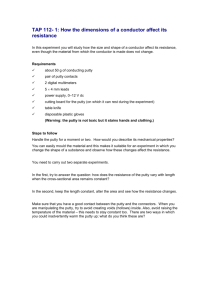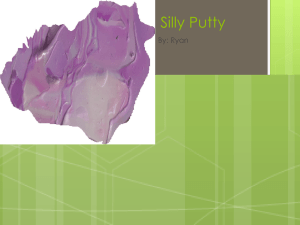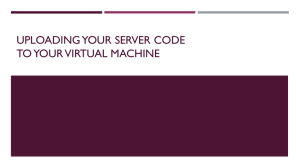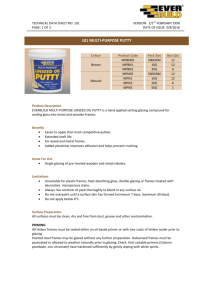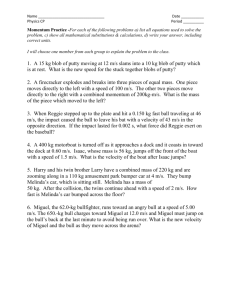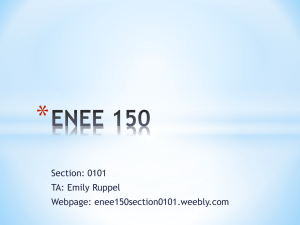A Hands-On Success
advertisement
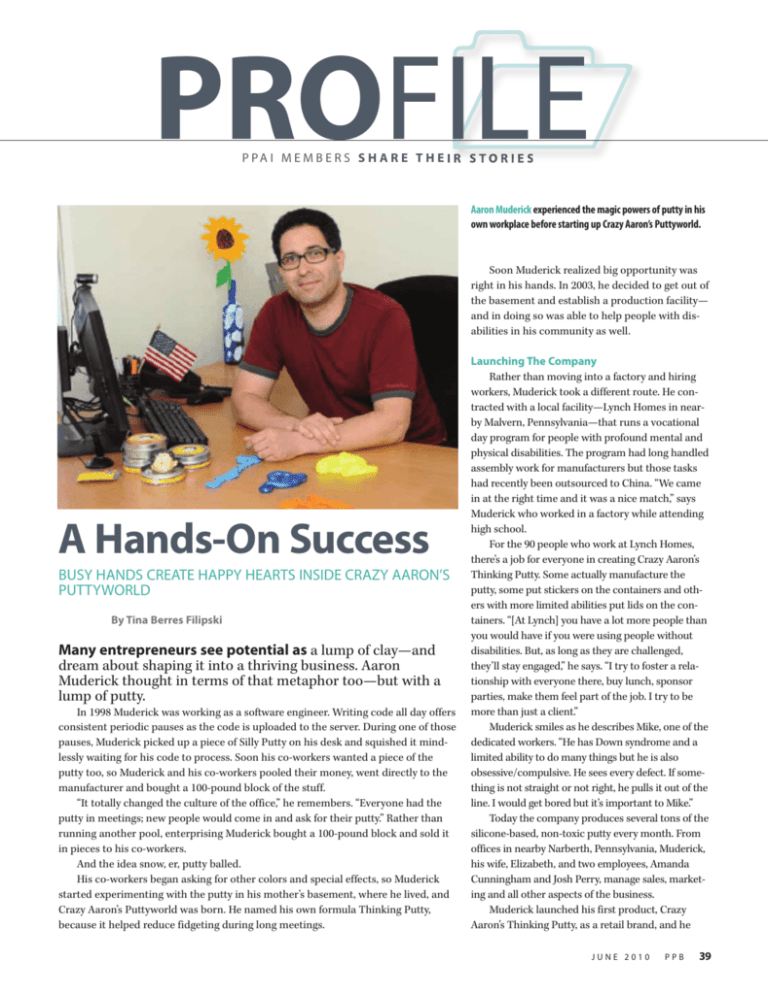
PROFILE P PA I M E M B E R S S H A R E T H E I R S T O R I E S Aaron Muderick experienced the magic powers of putty in his own workplace before starting up Crazy Aaron’s Puttyworld. Soon Muderick realized big opportunity was right in his hands. In 2003, he decided to get out of the basement and establish a production facility— and in doing so was able to help people with disabilities in his community as well. A Hands-On Success BUSY HANDS CREATE HAPPY HEARTS INSIDE CRAZY AARON’S PUTTYWORLD By Tina Berres Filipski Many entrepreneurs see potential as a lump of clay—and dream about shaping it into a thriving business. Aaron Muderick thought in terms of that metaphor too—but with a lump of putty. In 1998 Muderick was working as a software engineer. Writing code all day offers consistent periodic pauses as the code is uploaded to the server. During one of those pauses, Muderick picked up a piece of Silly Putty on his desk and squished it mindlessly waiting for his code to process. Soon his co-workers wanted a piece of the putty too, so Muderick and his co-workers pooled their money, went directly to the manufacturer and bought a 100-pound block of the stuff. “It totally changed the culture of the office,” he remembers. “Everyone had the putty in meetings; new people would come in and ask for their putty.” Rather than running another pool, enterprising Muderick bought a 100-pound block and sold it in pieces to his co-workers. And the idea snow, er, putty balled. His co-workers began asking for other colors and special effects, so Muderick started experimenting with the putty in his mother’s basement, where he lived, and Crazy Aaron’s Puttyworld was born. He named his own formula Thinking Putty, because it helped reduce fidgeting during long meetings. Launching The Company Rather than moving into a factory and hiring workers, Muderick took a different route. He contracted with a local facility—Lynch Homes in nearby Malvern, Pennsylvania—that runs a vocational day program for people with profound mental and physical disabilities. The program had long handled assembly work for manufacturers but those tasks had recently been outsourced to China. “We came in at the right time and it was a nice match,” says Muderick who worked in a factory while attending high school. For the 90 people who work at Lynch Homes, there’s a job for everyone in creating Crazy Aaron’s Thinking Putty. Some actually manufacture the putty, some put stickers on the containers and others with more limited abilities put lids on the containers. “[At Lynch] you have a lot more people than you would have if you were using people without disabilities. But, as long as they are challenged, they’ll stay engaged,” he says. “I try to foster a relationship with everyone there, buy lunch, sponsor parties, make them feel part of the job. I try to be more than just a client.” Muderick smiles as he describes Mike, one of the dedicated workers. “He has Down syndrome and a limited ability to do many things but he is also obsessive/compulsive. He sees every defect. If something is not straight or not right, he pulls it out of the line. I would get bored but it’s important to Mike.” Today the company produces several tons of the silicone-based, non-toxic putty every month. From offices in nearby Narberth, Pennsylvania, Muderick, his wife, Elizabeth, and two employees, Amanda Cunningham and Josh Perry, manage sales, marketing and all other aspects of the business. Muderick launched his first product, Crazy Aaron’s Thinking Putty, as a retail brand, and he JUNE 2010 PPB 39 PROFILE still maintains a retail website marketed mostly through Facebook and Twitter. But when clients began asking to put their own designs on the cans, he realized he could tap a new market—promotional products. In 2008 he joined PPAI and exhibited at the PPAI Expo for the first time. “It took me a while to figure out this industry, but I was amazed when I first walked on the show floor,” he says of the huge variety of products. “When someone comes to me with a new suggestion, we’ll come up with a custom idea.” Putty As A Promotional Product Thinking Putty has therapeutic properties. It keeps hands busy so it’s a good fit for special needs groups such as people with Attention Deficit Disorder (ADD), for example. Kneading the putty also helps to reduce stress, tends to clear the mind and spur creativity, so it’s a good fit for brainstorming sessions, seminars and similar business settings. Muderick offers this tip to distributors: If you have a client that wants to convince others it is creative, the client should use putty for a self promotion with a message such as “Stretch Your Imagination.” Ideal markets for this approach include graphic design companies and engineering firms. Crazy Aaron’s stocks 30 colors and can color match the putty to a specific logo color too. The company can also do a heatsensitive match where the putty changes colors as it comes in contact with warm hands or a cold glass. Packaging can also be customized, but more often than not customers opt for the standard round metal tins. Muderick explains that Thinking Putty does not need to be kept sealed (it will never dry out or crumble) but the metal tin lends a higher perceived value and is the perfect surface for message imprinting. A Pliable Business Model Working with a fun product such as putty is still serious business, and Crazy Aaron’s Puttyworld suffered through declining sales in 2009 just like other businesses. “We decided we could hunker down or come out guns blazing,” he says, explaining he made some internal cost-saving changes and began an idea service to help distributors sell the product. Thinking Putty is a product that needs some explanation and education, he admits, as some distributors don’t easily make the What Happens When You Drop A Ball Of Putty? CRAZY AARON IS TRUE TO HIS NAME. His craziest self promotion was a 100-pound putty drop involving a local radio station and firefighter’s ladder. From atop the ladder, he dropped a 100-pound putty ball. It bounced and rolled across the parking lot to the delight of the crowd that had gathered. He explains that distributors can offer something similar to their clients: instead of buying individual cans of putty, they can order a huge blob of the product and individual cans, and do their own putty ball drop. Then attendees can fill the cans themselves. connection on how to use putty. “They need ideas and concepts— such as slogans and creative concepts—so we provide that.” His best marketing technique is the tried-and-true approach of knocking on doors. He explains that he and his small team call every distributor who was scanned at the recent PPAI Expo, for example, believing that if you give people face time, they will repay you with attention. And it looks like his approach has worked—Crazy Aaron’s has enjoyed double-digit sales growth every year since 2003. While Crazy Aaron’s Puttyworld focuses 100 percent on its putty line, Muderick anticipates introducing some non-putty products in the future. Still the putty-related ideas keep coming. “I have some new putties in the works. Every time I think I’ve seen it all, I come up with a new idea. I’m always experimenting with cool packaging, especially for promotional products customers since packaging is so important. “I never dreamed that this is the direction my life would take,” says the former software engineer. “We’re not curing cancer but we’re definitely putting smiles on people’s faces.” Tina Berres Filipski is editor of PPB. QUICK LOOK: Crazy Aaron’s Puttyworld The company’s small-but-mighty team: Amanda Cunningham, Elizabeth Muderick, Josh Perry and Aaron Muderick. 40 PPB JUNE 2010 (UPIC: Putty) www.puttyworld.com Founded: 1998 Headquarters: Narberth, Pennsylvania Fun Facts: • Putty is the same density as the human body. • It stretches, bounces and can tear like paper. • It doesn’t leave a sticky residue on hands. • It’s CPSIA compliant and is safe to bring through airport security. • Press putty on a pencil drawing or ink jet print and it will transfer the image.
